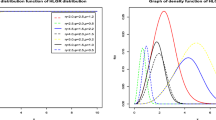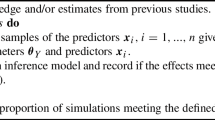Building of models in the Earth Sciences often requires the solution of an inverse problem: some unknown model parameters need to be calibrated with actual measurements. In most cases, the set of measurements cannot completely and uniquely determine the model parameters; hence multiple models can describe the same data set. Bayesian inverse theory provides a framework for solving this problem. Bayesian methods rely on the fact that the conditional probability of the model parameters given the data (the posterior) is proportional to the likelihood of observing the data and a prior belief expressed as a prior distribution of the model parameters. In case the prior distribution is not Gaussian and the relation between data and parameters (forward model) is strongly non-linear, one has to resort to iterative samplers, often Markov chain Monte Carlo methods, for generating samples that fit the data likelihood and reflect the prior model statistics. While theoretically sound, such methods can be slow to converge, and are often impractical when the forward model is CPU demanding. In this paper, we propose a new sampling method that allows to sample from a variety of priors and condition model parameters to a variety of data types. The method does not rely on the traditional Bayesian decomposition of posterior into likelihood and prior, instead it uses so-called pre-posterior distributions, i.e. the probability of the model parameters given some subset of the data. The use of pre-posterior allows to decompose the data into so-called, “easy data” (or linear data) and “difficult data” (or nonlinear data). The method relies on fast non-iterative sequential simulation to generate model realizations. The difficult data is matched by perturbing an initial realization using a perturbation mechanism termed “probability perturbation.” The probability perturbation method moves the initial guess closer to matching the difficult data, while maintaining the prior model statistics and the conditioning to the linear data. Several examples are used to illustrate the properties of this method.
Similar content being viewed by others
REFERENCES
Besag, J., and Green, P. J., 1993, Spatial statistics and Bayesian computation: J. R. Stat. Soc. B, v. 55, p. 3–23.
Caers, J., 2003, History matching under a training image-based geological model constraint: Soc. Petrol. Eng. J., SPE #74716, p. 218–226
Deutsch, C. V., and Journel, A. G., 1998, GSLIB: The geostatistical software library: Oxford University Press, New York, 369 p.
Hegstad, B. K., and Omre, H., 1996, Uncertainty assessment in history matching and forecasting, in Baafi, E. Y., and Schofield, N. A., eds., Geostatistics Wollongong, Kluwer, Dordrecht, v. 1, p. 585–596.
Hoffman, B. T., and Caers, J., 2003, Geostatistical history matching using the regional probability perturbation method, in Proceedings of the SPE Annual Conference and Technical Exhibition, Soc. Petrol. Eng., Paper no. 84409, Denver, CO, October 5–8, 16 p.
Hoffman, B. T., and Caers, J., 2004, History matching with the regional probability perturbation method—Applications to a North Sea reservoir, in Proceedings of the ECMOR IX, Cannes, August 29 – September 2, 2004.
Hu, L.-Y., Blanc, G., and Noetinger, B., 2001, Gradual deformation and iterative calibration of sequential simulations: Math. Geol., v. 33, p. 475–489.
Journel, A. G., 1993, Geostatistics: Roadblocks and challenges, in Soares, A., ed., Geostatistic-Troia: Kluwer Academic, Dordrecht, v. 1, p. 213–224.
Journel, A. G., 2002, Combining knowledge from diverse data sources: An alternative to traditional data independence hypothesis: Math. Geol., v. 34, p. 573–596.
Metropolis, N., Rosenbluth, A. W., Rosenbluth, M. N., Teller, A. H., and Teller, E., 1953, Equation of state calculation by fast computing machines: J. Chem. Phys., v. 21, p. 1087–1092.
Moosegard, K., and Tarantola, A., 1995, Monte Carlo sampling of solutions to inverse problems: J. Geophys. Res. B, v. 100, p. 12431–12447.
Neal, R. M., 1993, Probabilistic inference using Markov chain Monte Carlo methods: Technical report CRG-TR-93-1, Department of Computer Science, University of Toronto.
Omre, H., and Tjelmeland, H., 1996, Petroleum geostatistics, in Baafi, E.Y., and Schofield, N. A. eds., in Geostatistics Wollongong: Kluwer, Dordrecht, v. 1, p. 41–52.
Strebelle, S., 2002, Conditional simulation of complex geological structures using multiple-point geostatistics: Math. Geol., v. 34, p. 1–22.
Suzuki, S., 2003, Determining petrophysical properties of facies using a hierarchical history matching method: MSc Thesis, Stanford University, Stanford, CA.
Tarantola, A., 1987, Inverse problem theory: Elsevier Science, Amsterdam, 613 p.
Author information
Authors and Affiliations
Rights and permissions
About this article
Cite this article
Caers, J., Hoffman, T. The Probability Perturbation Method: A New Look at Bayesian Inverse Modeling. Math Geol 38, 81–100 (2006). https://doi.org/10.1007/s11004-005-9005-9
Received:
Accepted:
Published:
Issue Date:
DOI: https://doi.org/10.1007/s11004-005-9005-9




